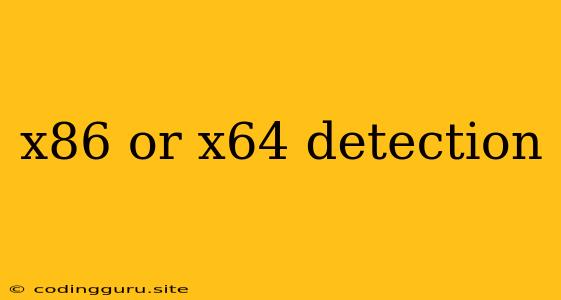Determining Your System Architecture: x86 vs x64
In the world of computing, understanding your system's architecture is crucial, particularly when it comes to software compatibility and performance. Two primary architectures dominate the landscape: x86 and x64, also known as IA-32 and AMD64 respectively. These architectures define how your computer processes data and instructions.
But how do you know which architecture your system uses? This is where x86 or x64 detection comes into play.
Why is x86 or x64 Detection Important?
- Software Compatibility: Not all software is built to run on both architectures. Certain programs might only be available for x86 or x64 systems.
- Performance: x64 systems generally offer better performance due to their ability to handle larger amounts of memory.
- Troubleshooting: Knowing your system's architecture can be helpful in resolving software or hardware issues.
Methods for x86 or x64 Detection
Here are some common methods for determining your system's architecture:
-
System Information Tools:
- Windows:
- System Information: Press Windows Key + R, type
msinfo32, and press Enter. Look for System Type under System Summary. - Task Manager: Open Task Manager (Ctrl + Shift + Esc), click the Performance tab, and check the CPU section for the architecture.
- System Information: Press Windows Key + R, type
- macOS:
- About This Mac: Click the Apple menu and choose About This Mac. Look for the Processor information.
- Linux:
- Terminal: Open a terminal and run the command
uname -m. This will display your system's architecture (e.g., i686 for x86 or x86_64 for x64).
- Terminal: Open a terminal and run the command
- Windows:
-
Software Applications:
- CPU-Z: This popular freeware utility provides detailed information about your computer's hardware, including the CPU architecture.
- Speccy: A comprehensive system information tool that displays the architecture under the CPU section.
-
Processor Information:
- Intel Processors: Look for the "Intel Core i3", "Intel Core i5", "Intel Core i7", or "Intel Core i9" branding on your processor. These are all x86 or x64 compatible.
- AMD Processors: Similar to Intel, check for the "AMD Ryzen", "AMD Athlon", or "AMD FX" branding on your processor. These are also x86 or x64 compatible.
Understanding the Architectures:
- x86 (IA-32): This is the original 32-bit architecture that has been around for decades. It is still used in some systems, but most modern computers use x64.
- x64 (AMD64): This is a 64-bit architecture that was introduced in the early 2000s. It offers significant performance improvements over x86, particularly in terms of memory handling.
Troubleshooting x86 or x64 Issues:
- Software Compatibility: If a program isn't compatible with your system's architecture, you may need to find an alternative version or update your system.
- Performance Issues: If you're experiencing performance issues and suspect an architecture mismatch, try running a program on a different system or contacting the software developer for support.
Conclusion
Knowing your system's architecture is essential for various tasks, including software compatibility, performance optimization, and troubleshooting. Using the methods outlined above, you can easily determine whether your system runs on x86 or x64. This information will help you choose the right software, make informed decisions about system upgrades, and navigate the complexities of the modern computing world.
